Even without a clear view, the women are cheering. With whoops and supportive hollers, they see the surfer from the waist up; glistening black wetsuit, soaked hair fluttering from riding a nine foot longboard.
There’s nothing new about a female admiring a surfer. But these are not teens on sandy towels watching from the beach. Instead, the rider is zooming away from them, heading towards shore. From astride their own boards, the swelling wave conceals more and more until only the surfer’s head is visible and it’s not clear how her ride ends: perhaps one wobble too many and a splash, or maybe a triumph, victorious fists pumping the air. This is what surfing looks like from the lineup. And this lineup is all women.
Riding a long, pine plank, Hawaiian Duke Kahanamoku brought the ancient Polynesian pastime of surfing to Australia’s shores in the summer of 1914/15. Aussies eagerly embraced it as part of an emerging beach culture which valued active men and decorative women. As the sport’s popularity grew, more riders competing for less waves shaped an increasingly aggressive surf culture. Women largely faded from the scene. Only the most determined endured decades of thin tolerance of ‘chicks and sticks’ (the ‘sticks’ refers to the board) and overt misogyny as portrayed in the fictional 1979 Puberty Blues novel by Gabrielle Carey and Kathy Lette, and eye-opening 2022 documentary Girls Can’t Surf.
There’s a direct line of inspiration from Duke’s century-old surfing exhibitions at Sydney’s Freshwater and Dee Why beaches to the women here in the water near Mollymook, three hours south of Sydney. It comes first via Isabel Letham, the 15-year-old “Freshie” local who Duke pulled from a crowd of sightseers to demonstrate riding tandem. This act cemented Isabel’s place in Australia’s surfing history and started a chain of ‘If she can…’.
The next link is another former Freshwater local, and the reason this group of eight women woke before dawn to squirm into wetsuits and paddle out. It’s Pam Burridge, 1990 world surfing champion and six-time runner-up, recognisable to a generation of women who loved the ocean even if they weren’t surfing themselves.
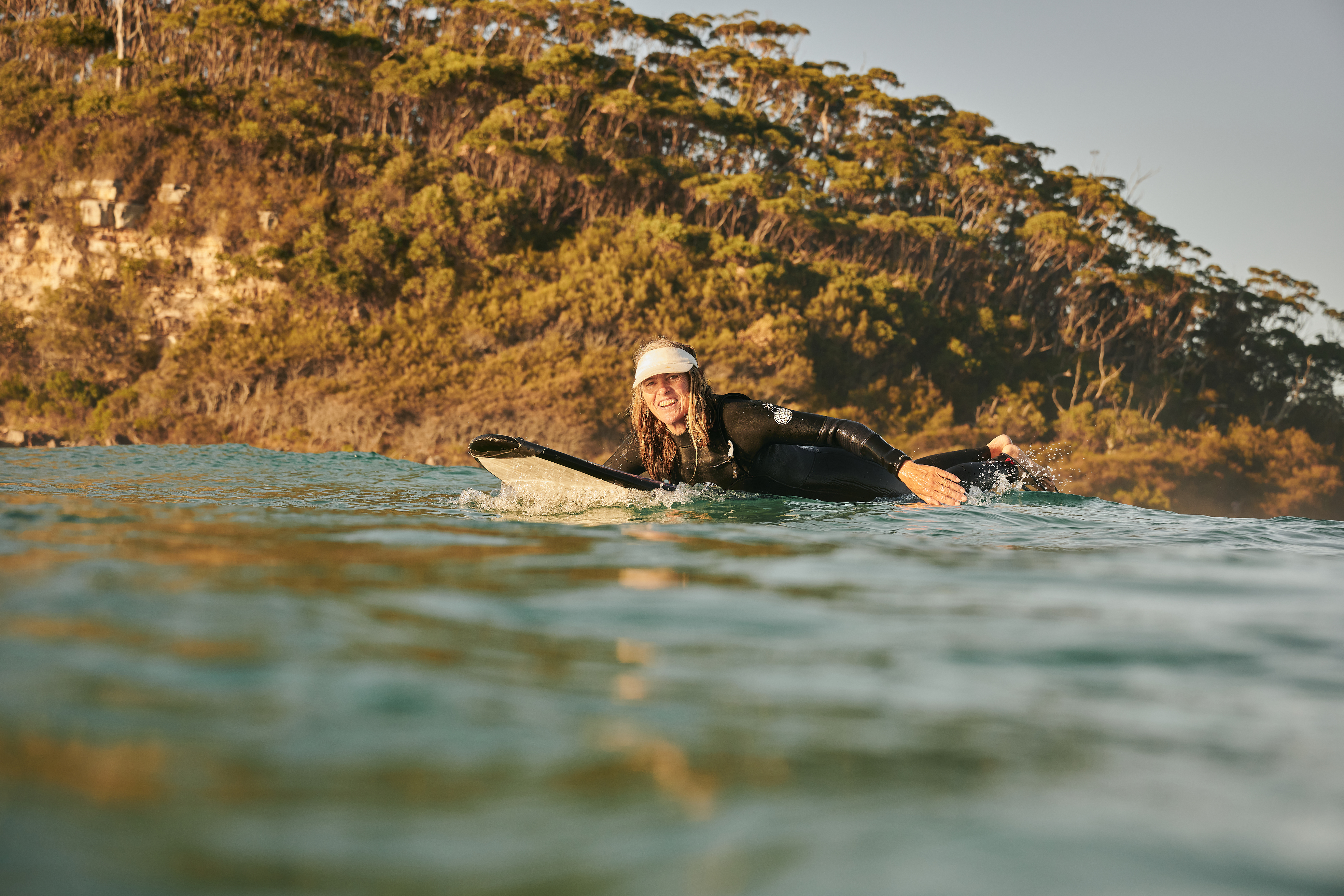
A decade before her big win and aged 15 – the same as Isabel when she’d stood on Duke’s board – Pam turned pro at one of the first surfing competitions specifically for women. An 81-year-old Isabel – later the namesake of Pam’s firstborn – was watching the competition from the sand. “I should be home with my knitting,” she was quoted as saying. “But I’ve waited 65 years for this.”
At 58, Pam is still riding the waves of change, from her own poorly paid (or often unpaid) time on the professional circuit to women finally earning equal prize money in 2019. The biggest shift though, is cultural.
From being one of the only girls in the water and feeling “under threat a lot of the time” she’s now witnessing girls aged between 15 and 17 surfing at nearly the same rate as boys (according to research commissioned by the Australian Government) a result Pam partly attributes to generational change.
“A lot of those guys who were out in the water being d**kheads – sending you back into the beach if you were a girl. Now they have daughters who want to surf so they’re like, ‘oh, what about my daughter?’”.
But it’s not just teens who are riding the wave of change. Today, Pam is encouraging more women of her generation to get on board.
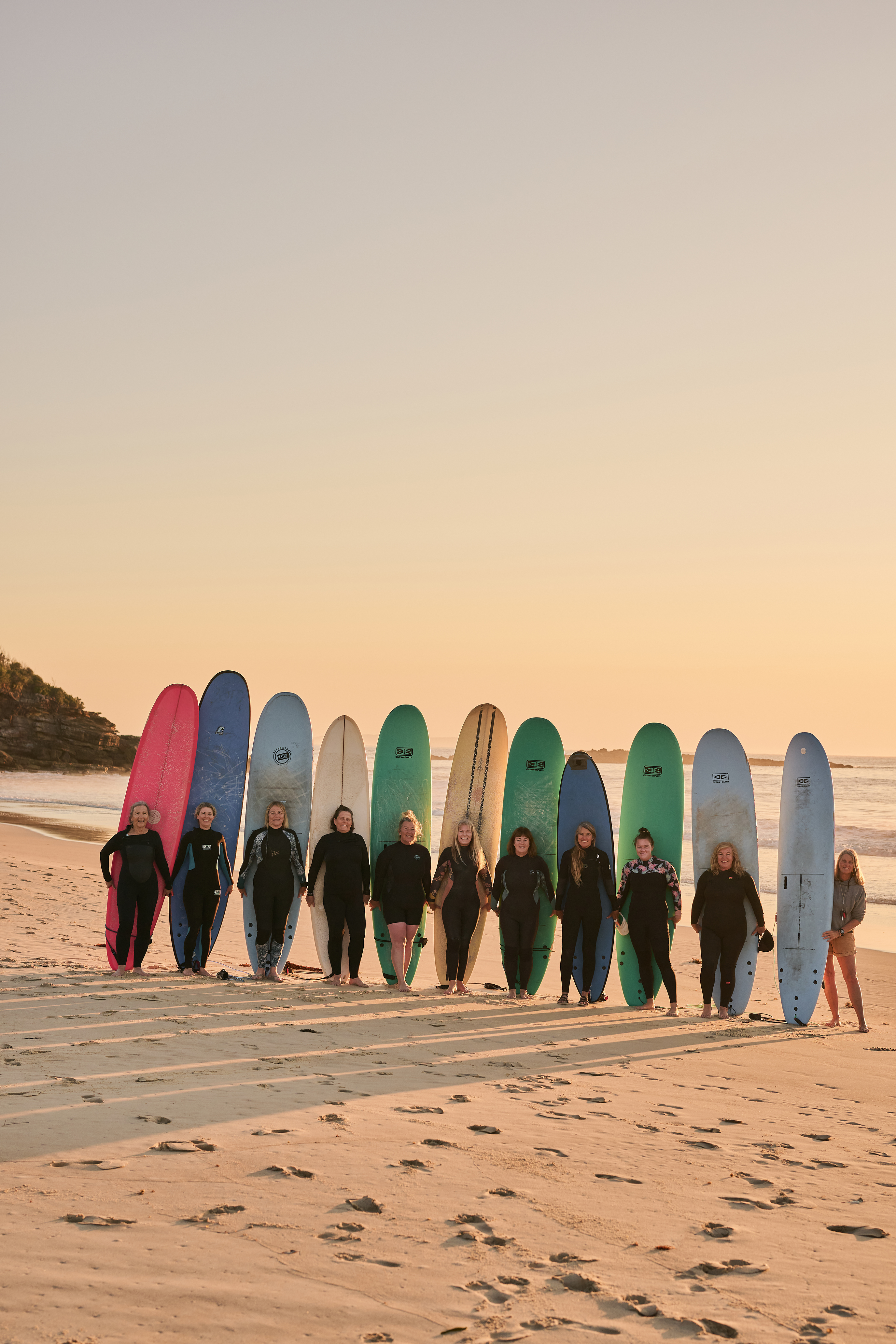
Kangaroos nibbling beach spinifex, ready to leap away among paperbark trees if disturbed, are oblivious to the living legend in the water. Pam is focused on positioning the nearest woman correctly on her board, priming her to capture the oncoming wave’s force, often with Pam’s helpful push. Somehow though, she is also watching the previous rider’s attempt and will be ready with quiet instruction and encouragement when they paddle back out. Pam also carries an instinct for waves the rest of the group can’t yet see, moving the women back if a particularly large set is on its way.
In the same way that not every surfer makes a good instructor, being a world champion surfer doesn’t necessarily make the world’s best teacher. But Pam’s students – the eight women in this weekend’s surf retreat group, a drop in the ocean of her two decades of surf school teaching – credit their success to Pam’s guidance. Speaking last night over welcome drinks and recalling her months of twice-weekly tutelage under Pam, 50-year-old pupil Kirra Dowling says, “She loves sharing the froth.”
Many of this weekend’s group of surfing students are teachers themselves, albeit ones more accustomed to classrooms than rolling waves. Mainly in their 50s and 60s (with a lone 35-year-old outlier), they share a lifelong love of the ocean and a more recent discovery that surfing is no longer just for the boys… or for young ones.
For retired Physics teacher, Donna Miles, 69, the impetus came from watching her own students. Ten years ago she had volunteered to supervise surfing for school sports and realised she’d rather stay in the water even when the kids got out. Donna decided, “I wanted to catch a green wave before I turned 60.” And she did, graduating from being pushed along by the whitewash to surfing unbroken, or green, waves.
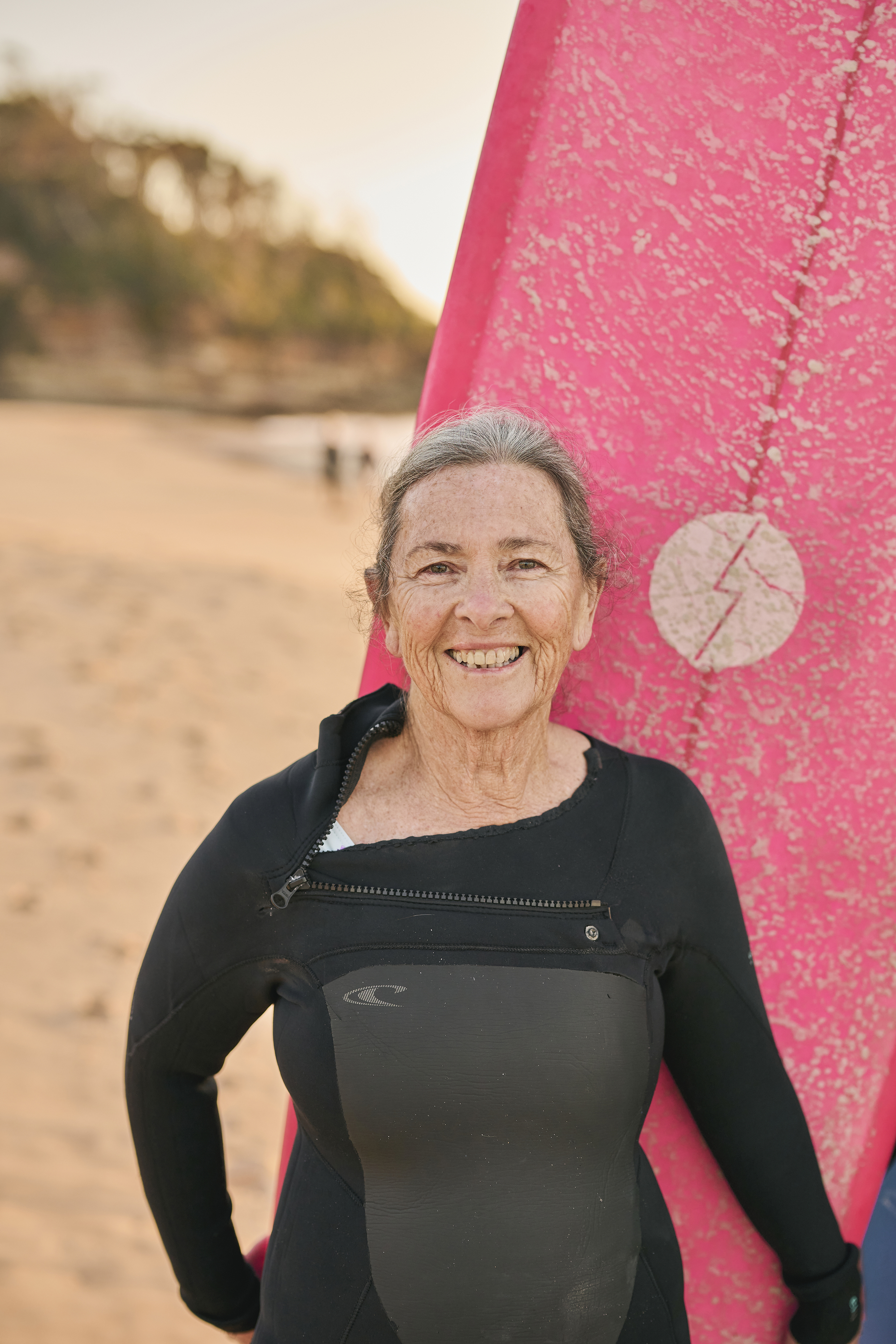
Donna found an ally in her boss, Ulladulla High School principal Denise Lofts. Unlike Pam’s usual surf lessons, weekend retreats require a group familiar enough to bunk in together. Denise is the link connecting them all. Growing up near the ocean, Denise says you couldn’t keep her out of the water, enjoying a childhood of endless swimming and sunburn and surf mats (those navy and red inflatable rubber mattresses perfect for bashing about in the shorebreak).
“Then I hit high school and it all changed because girls didn’t do that sort of stuff,” says Denise, 59. “We sunbaked and had a dip to cool off but we didn’t surf at all. I was keen but never pursued it.”
Instead she sat on the beach watching boyfriends surf, then her husband, then their three sons. Time ticked by until Denise was pushing 50. It was not so much the approaching big birthday but a move to Mollymook that became the catalyst for Denise to finally pick up a board. Her kids were older, work was still busy but now the ocean was right there and how many towns of 1200 residents can boast a former world surf champ?
“I couldn’t wait any longer, really”, recalls Denise so when she spotted Pam, by then a surf school operator, at a local surf break where she and a friend were muddling through, she paddled over and asked, “If I put a group together, would you come and help me?” Explains Denise, “I thought, I’m never going to do this unless I have people around me doing it too.” And thus began the ‘No Excuses’ group (“because I’d heard all the excuses after saying, ‘I really want to learn how to surf’”) and an open invitation to meet for a weekly surf with Pam guiding the way.
Over time the group morphed into a smaller collective of regular faces who call themselves, tongue-in-cheek, the Princesses. “To be a surfer, you’re not a princess. You can’t be. Like, it’s bloody hard,” says Denise.
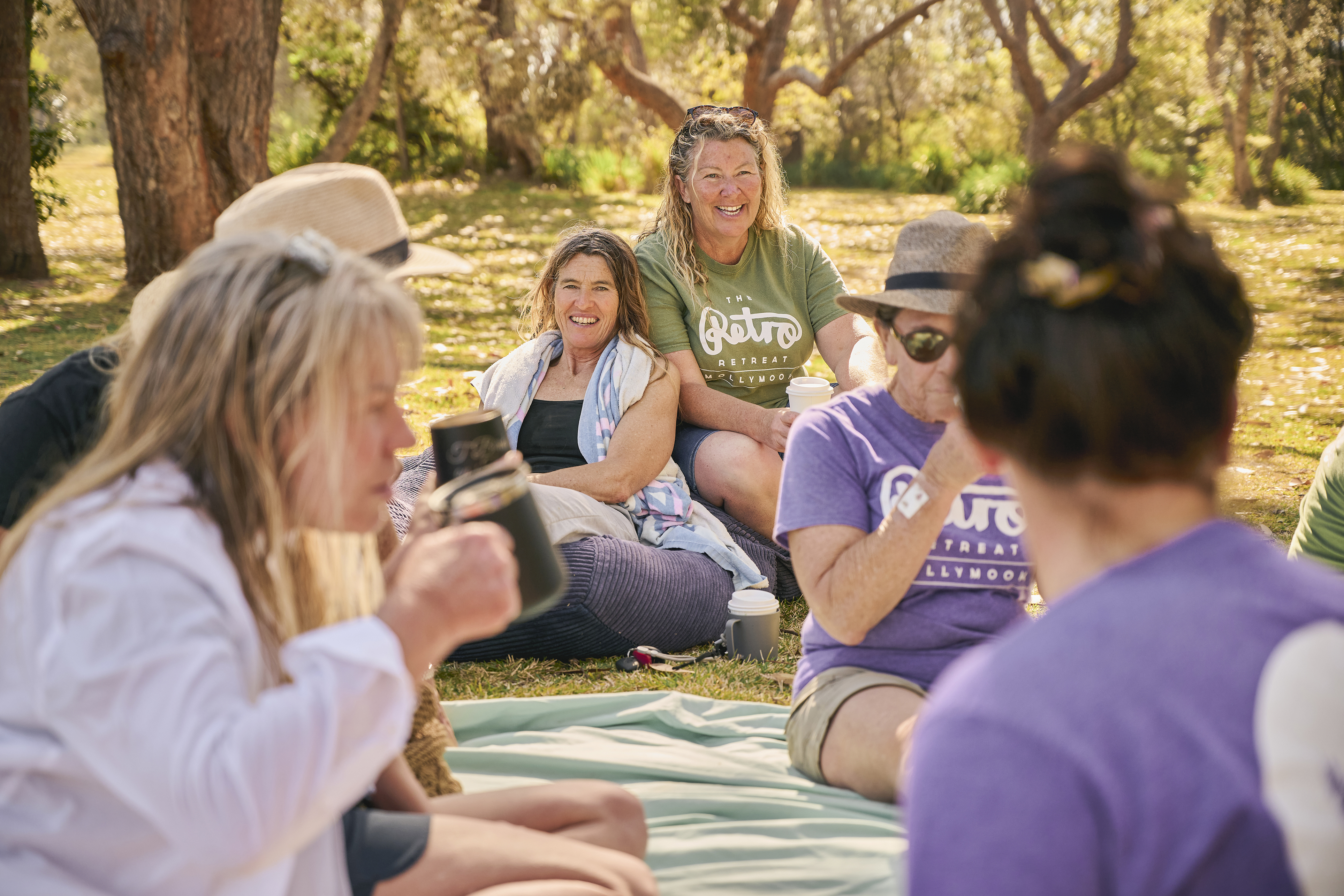
Around the same time, one of Denise’s former surf boat colleagues from Sydney, Kristen Wild, was turning 40 and wanted a change. Despite growing up by the Murrumbidgee River five hours west of the coast, Kristen loved her family’s annual saltwater dose at Mollymook. She decided to learn how to surf. “I wanted to challenge myself and I remember saying,” – she shakes her head at the memory – “how hard can it be?”
Pam knows. “You have to understand the conditions you’re dealing with, probably more so than a young person who’s willing to take some beatings. You’ll still take some as a surfer – you’ll fall off and get bumped around – but you don’t want to hit your board or hit the sand or hit another person.”
Then there’s paddling out beyond the break which, depending on conditions, can be a hard slog. “If you’re going to be a surfer, it has to get a little hook in you because we don’t have perfect waves every day.”
That “little hook” Pam speaks of happened to Kristen who, now 53, says her life changed because of surfing. She moved house to live near the beach, her friendship circle are now surfers and her holidays revolve around surfing internationally. “I love the challenge and that no surf is the same. And I love the way it makes me feel. It’s just given me so much, especially when my mum passed away. It’s been a place of peace and solace.” Put simply, says Kristen, “I am a better person when I surf.”

Kirra understands the feeling. “When I’m out in the water, it’s like I can breathe.” Years ago she had turned up with her 9-year-old daughter to an event staged by surf brand, Roxy, that aimed to encourage more girls to surf. Kirra ended up being the one in the water, despite being so scared of sharks that “the only time I went out past the breakers was when I did the [surf club] reassessment each year.”
She describes the lingering judgments she still feels when paddling out on a sturdy foam board to a lineup of men on sleeker, faster fibreglass boards. “I’m older, I’m on a foamie, I’m carrying a bit of weight and they’re looking at me. Then I catch a wave,” Kirra pauses to he-heh like a despot planning world domination, “then I come back and catch another one.”
Krista Barry runs her own surf school on the Gold Coast. And it was seeing older women have similar experiences that prompted her to study the phenomenon. On starting her thesis as part of a Masters in Applied Positive Psychology at Central Queensland University, she noticed previous research had focused solely on men. A recent Bond University study had found that middle-aged men who’d surfed for years had higher bone mineral density, a protective factor against osteoporosis – for which women need to be particularly alert to. It was time to hear from women taking part in structured surf programs.
“What I found is that women brought bravery to it,” Krista says of her observations. Instead of being timid and frightened – although they were nervous – they had courage to step up and try.”
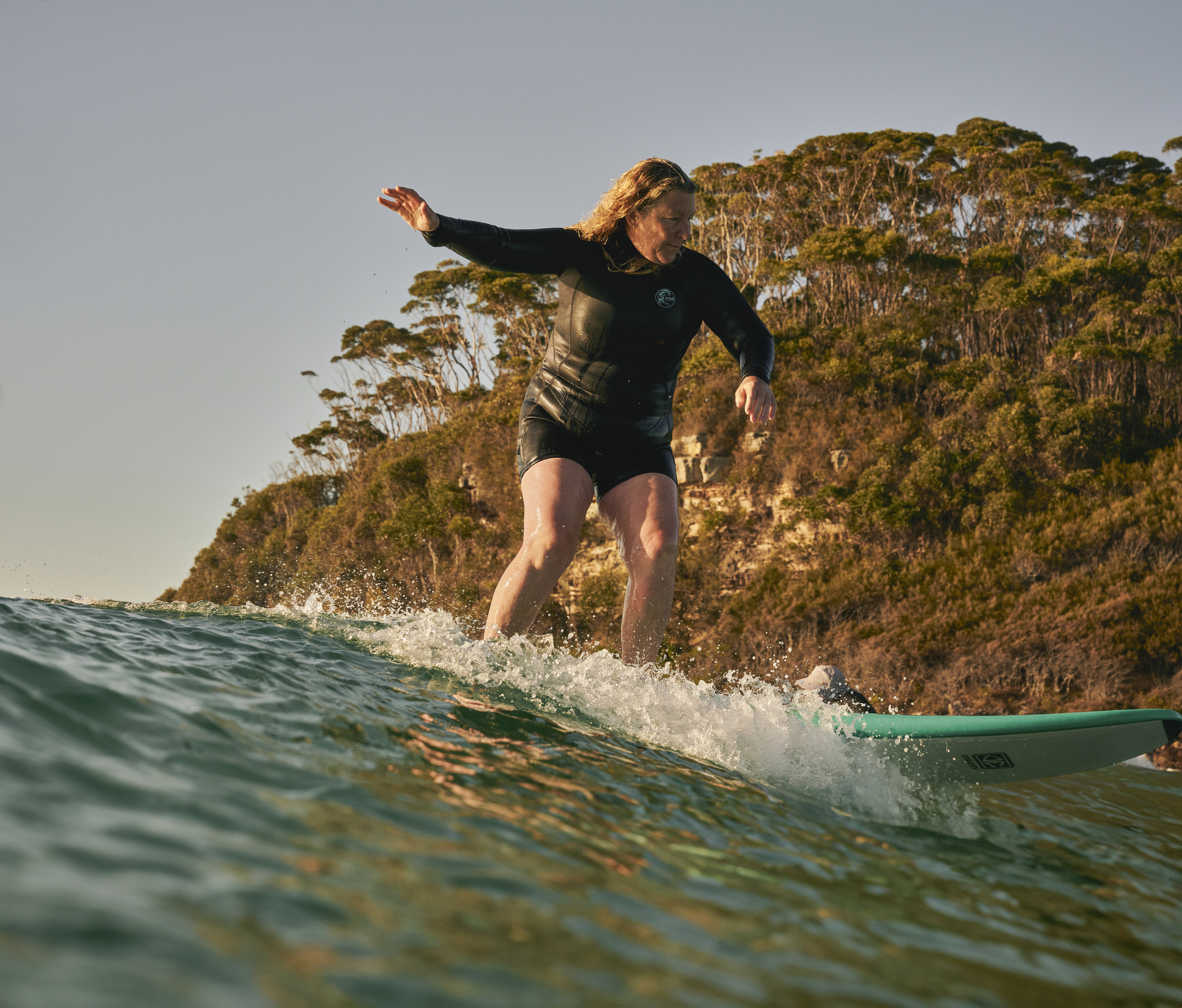
But for women learners to feel safe in the water they need a handful of factors, all of which rely on the instructor. “The coach is their centre, their rock,” says Krista, explaining that women must have confidence that the instructor will take them to the best waves for learning, be judgement-free (both of their abilities and bodies) and create a friendly atmosphere.
“When you’re in a natural environment, particularly water where conditions can change within five minutes, the instructor must be able to connect with women,” says Krista. “Even if they’re the greatest surfer in the world, if they can’t communicate and understand what women at certain ages go through with different changes in their bodies…”
Sometimes that might mean compromising on the perfect ‘pop-up’, where a surfer springs to their feet in one swift movement after paddling onto the wave. Karyn Ingold, 60, spells it out. “Pam knows that for some of us we’re not going to be able to jump to our feet. It shouldn’t be knee, knee, foot, foot but sometimes that’s just how it is.”
Krista’s research confirms that success lies in meeting a learner where she’s at. “A lot of women want to be pushed a little bit but they don’t want to be shoved.” Instead of the simple ‘have a go’ approach more favoured by men, this is where regular lessons or the camaraderie of a surf retreat benefits. “They know the instructor’s there, that other women are there, they’re not alone. The bravery comes from knowing they’ve got these elements that will support them in that journey.”

As many in the group approach a significant birthday – Pam and Denise are heading towards 60, Donna will soon be 70 – Kirsten gleefully repeats a quote about surfing attributed to 11-time men’s world champion, Kelly Slater: “It’s like the mafia. Once you’re in, you’re in. There’s no getting out.”
Considering future milestone birthdays as a surfer, the women discuss the possibilities of using different boards, spending more time on strength and flexibility, and listening to their bodies more closely. Denise is adamant she will still be surfing at 80, the age Isabel Letham felt she was supposed to be at home knitting. Pam’s got her eye on the future; “It’s just planning into the fact that you want to be a strong, vibrant person doing the things you love. Especially when you have the time to do them.”
PHD candidate Krista, 56, hopes that her research will help inform initiatives to encourage more older women to experience the simultaneous challenge and deep restoration that comes from picking up a board. “What I love about an older woman surfing is the way I’m inspired, even though she doesn’t know she has inspired me. It’s because of the way she’s approached surfing and just loved it. And that shows me that I can get out there too.”
Pam has a final reminder to anyone considering being an older grommet: “Bring it back to the joyful elements and wind back your expectations. And then you’re much more likely to have a really good time.”










